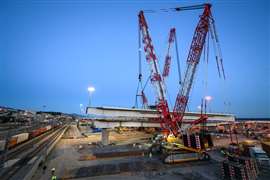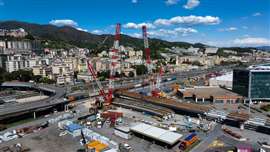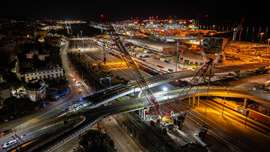Vernazza Autogru uses Tadano crawler cranes to lift Genoa shipyard bridge
20 November 2024
 Photo: Tadano/Vernazza Autogru
Photo: Tadano/Vernazza Autogru
As one of Italy and Europe’s biggest ports, Genoa in Northern Italy, is also one of its busiest, making closing roads or railway lines in order to carry out construction a headache.
Since the city’s Morandi Bridge tragically collapsed in 2018, the city has been embarking on an ambitious city-wide recovery plan aimed at upgrading key infrastructure across the city.
So, when Europe’s largest shipbuilding company Fincantieri decided to install a new bridge structure at the entrance to its Porto di Prà shipyard, to the west of the city’s main port terminals, across some of the city’s most important transport corridors, the pressure was on to keep construction time to the shortest window possible.
The new bridge crosses one of Italy’s most important state highways, the SS1 which connects Rome with France as well as the busy Genoa-Ventimiglia railway line.
 Photo: Tadano/ Vernazza Autogru
Photo: Tadano/ Vernazza Autogru
For Fincantieri, this meant opting for a prefabricated steel and concrete structure which could be lifted into place to sit on specially constructed pillars.
To do the job this summer, Fincantieri hired Italian crane service provider Vernazza Autogru, based in the nearby town of Vado Ligure.
Sectional bridge
Due to its size, the bridge had to be transported to site in two sections weighing 500 and 290 tonnes each before being carefully lifted onto the pillars.
All traffic routes were closed during the lifts, putting the pressure on the teams to complete the lifts within set timeframes at the port’s access area.
To undertake the work, Vernazza Autogru used two Tadano lattice boom crawler cranes, a 1,250 tonne capacity CC 68.1250-1 and a 650 tonne CC 38.650-1.
“These demanding lifts needed cranes that would not just be able to lift extremely heavy loads but also to move them while suspended in the air,” says Marco Galli, technical manager at Vernazza Autogru. Who was responsible for the project.
 Photo: Tadano/ Vernazza Autogru
Photo: Tadano/ Vernazza Autogru
First, a tandem lift was used to lift the 500 tonne bridge section. The CC 68.1250-1 was set up in SSL configuration with superlift. It had a 72 metre boom, and 450 tonnes of superlift counterweight.
The CC 38.650-1 was also set up in SSL configuration and with a 72 metre boom, but with 325 tonnes of superlift counterweight. The two cranes lifted and moved the 500 tonne section together at a radius of 50 metres and a height of seven metres.
Then the smaller, 290 tonne, bridge section was lifted using just the CC 68.1250-1 at a radius of 41 metres and a height of nine metres.
“We used an eight-person team, consisting of two crane operators and six supervisors and signal people, to lift the 500 tonne platform and put it in place with our two cranes. Meanwhile, the team we used to handle the smaller load with the CC 68.1250-1 alone had five people only,” says Galli.
CONNECT WITH THE TEAM





